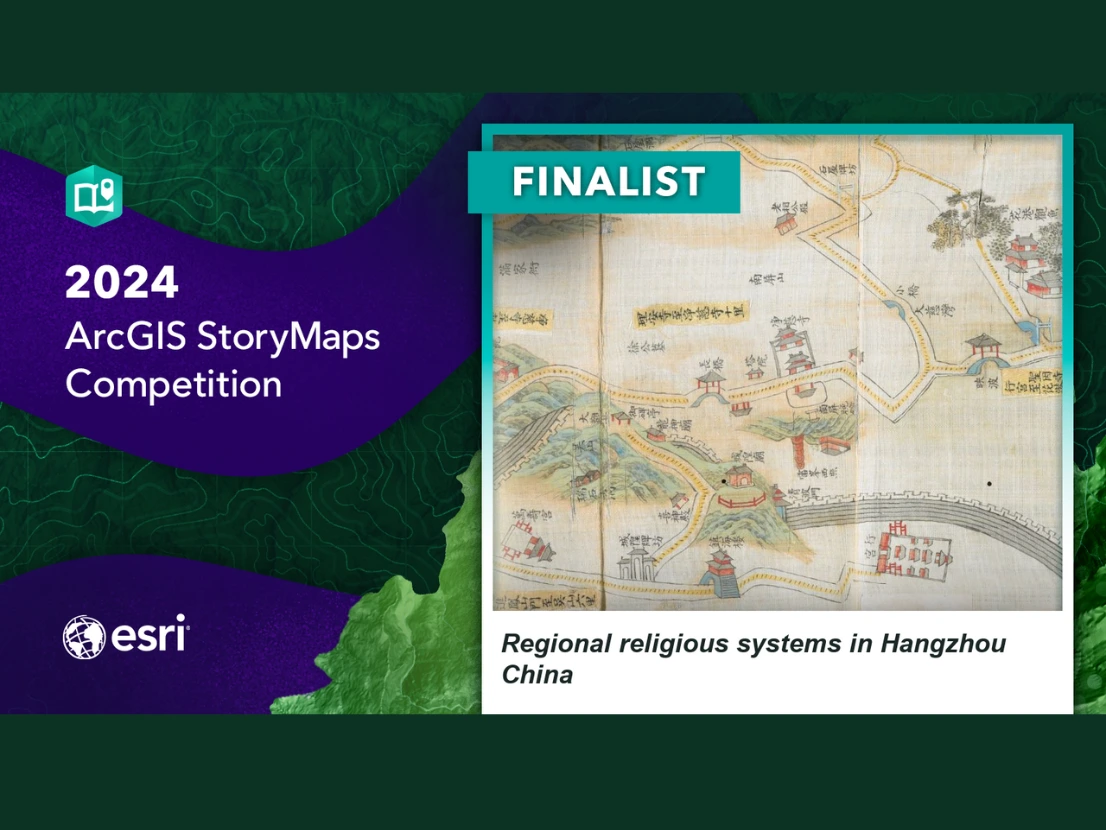
Dear Friends of the Center for Buddhist Studies,
Great news!
Our StoryMap, Regional Religious Systems in Hangzhou, China: Illustrating the Confluence of Buddhist Geography and Culture (618–2022) (Explore the StoryMap), has been selected as a finalist in the "Digital Humanities and Popular Culture" category of the 2024 ArcGIS StoryMaps Competition. The finalists were announced on February 12 on the ArcGIS Blog:
Read the announcement.
Now, we need your support to win the "Community Choice Award."
Please vote for our StoryMap here:
Vote Now
- Click "Vote Now"
- Find our StoryMap: Regional Religious Systems in Hangzhou, China
*The projects are listed alphabetically* - Submit your vote
Voting is open from February 12 to March 12.
This year, over 570 storytellers from 58 countries submitted entries in 10 languages for the competition. Storytellers from around the world, including students and professionals, competed in five categories:
- Digital Humanities and Popular Culture
- Health and Safety
- Humanitarian and Disaster Response
- Nature and Physical Science
- Planning and Infrastructure
We are honored to receive high praise from the ArcGIS StoryMaps team.
About the Team
Authors:
- Glenn Ingram – Former Master's Student in Urban Planning, University of Arizona
- Dr. Philip Stoker – Associate Professor of Urban Planning, University of Arizona
- Dr. Jiang Wu – Professor, Department of East Asian Studies & Director, Center for Buddhist Studies, University of Arizona
Assistants:
- Mattea Wallace – Graduate Student, School of Landscape Architecture and Planning, University of Arizona
- Dr. Jeffery Liu – Former data assistant, PhD in East Asian Studies, University of Arizona; now Assistant Professor, Department of History, University of South Dakota
- Ziling Wan – Data Assistant, PhD Candidate, East Asian Studies, University of Arizona
The team collaboration brings together the information and data that Dr. Wu and his team have developed and the cartography and design capacity of Dr. Stoker and his team. This project was initiated when Dr. Wu attended a cartography workshop taught by Dr. Stoker at the University of Arizona. During the event, Dr. Wu discussed his historical GIS work and the two wrote grant proposal to develop the work further. Funded by the College of Architecture, Planning, and Landscape Architecture, the two hired Glenn Ingram to help develop both the website and maps and as a team they completed the story map in this competition.
About Our StoryMaps
Spatial analysis of landscapes, history, and geography of Chinese buddhism has the potential to improve current understanding of regional patterns of Chinese culture and society for both students and scholars. In this digital atlas, we present the combined methods of spatial humanities, regional studies, and GIS mapping technologies under the framework of Regional Religious Systems (RRS). RRS research recognizes the clear regional and local pattern in creating "national" events and phenomena. The regionalism and localism emphasizes that the physical, administrative, cultural, and socio-economic growth across China was directly shaped by physical and spatial forces. This framework demonstrates the unique spatial formation of religious sites in China is deeply entwined with various regional and local factors. This approach has the potential to break the traditional paradigm of “nation-state” as a way to study religion and culture internationally. The purpose of this digital atlas is to present a few of the connections between physical landscapes and historical and religious patterns of development in Hangzhou.
Datasets have been developed by the Buddhist Geographic Information System (BGIS) and Regional Religious Systems (RRS) projects supported by the Center for Buddhist Studies, The University of Arizona and Lingyin Temple, Hangzhou, China. Pilgrimage route data was provided by Nan Ouyang and can be found in The formation of regional reiligous systems in greater China, Chapter 4.
Explore the StoryMap

